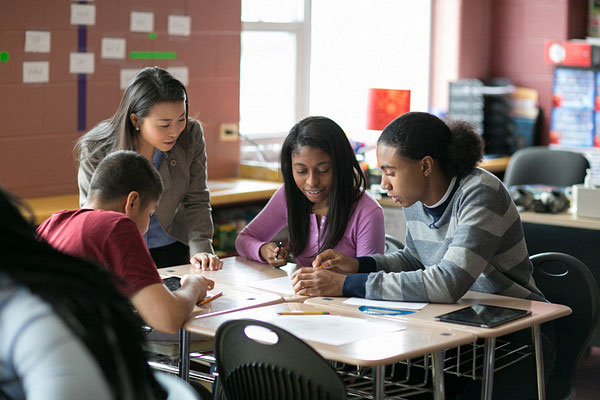March 5, 2020
MTSS is a framework with a tiered infrastructure that uses data to help match academic and social-emotional behavior (SEB) assessment and instructional resources to every student’s needs.
But despite educators’ dedication, the work of supporting each and every student’s needs presents clear logistical challenges. And those challenges are even greater for educators working at the high school level.
In this blog, I’ll explain why course placement can’t take the place of an effective MTSS system for secondary students. I’ll also outline three examples of MTSS interventions and provide strategies for making MTSS work at the high school level.

The challenges of supporting the needs of high school students
In high school, educators are teaching hundreds of students each day, often in six back-to-back class periods. They’re doing course placement gymnastics to enable credit attainment while still honoring student voice and choice. They’re also supporting students with a heightened number of possible SEB and academic struggles.
As a district-wide MTSS coordinator and secondary math teacher, I felt these challenges deeply. The trouble with having so many demands regarding schedules—credit attainment, college-readiness, graduation eligibility, etc.—is that we sometimes start to think of course placement as our MTSS system for high school students.
There are several problems with this approach, however.
Why can’t course placement be an MTSS?
If a student enters grade 9 without mastering grade 8 math standards, we might place that student in a remedial math class. While this may be an appropriate instructional decision, doing so in and of itself does not constitute implementing a multi-tiered system of supports. Why not?
It pertains to the difference between standards and skills:
- Standards are the specific, hierarchical learning goals expected of all learners in a given grade, grade range, or area of study. Think of standards as the road students are driving along.
- Skills are the abilities needed in order to use one’s knowledge effectively and readily in execution or performance. Think of skills as the foundation under the road that allows for smooth travel. With too many missing skills (holes in the foundation), it’s hard to navigate the road.
Standards mastery is provided by high-quality, standards-based curriculum and instruction. Skills gaps can be “filled in” by providing targeted interventions. Every student deserves grade-level standards-based instruction. Every student who struggles with the skills needed to master those standards or who needs additional challenges deserves interventions.
At secondary, just as in primary, each student needs to receive instruction based on grade-level standards. While putting a student in a remedial math class might be necessary in some situations, it also poses two issues:
- It sometimes takes students out of the classes that are providing the instruction they should be receiving on grade-level standards.
- It doesn’t allow room for them to get any actual intervention (addressing a missing underlying skill), due to the fact that their schedules are now filled up with courses.
Many of the challenges we face in implementing MTSS at the secondary level come down to this very struggle: we have students with a variety of needs, but we also have complexities, obligations, and limitations due to schedules, time, and resources.
So, what can we do?

5 strategies for implementing MTSS interventions for high school students
Here are five strategies we used in my district that you might be able to adapt or adopt in your own district, based on your available resources and your students’ level of need.
#1: Build flexible time into the master schedule (Tier 2 and Tier 3)
While moving kids in and out of courses isn’t an intervention (i.e., it doesn’t necessarily help them build a missing skill), our schedules can help us unlock time that we can dedicate to an intervention.
One strategy is to build a flexible period into student schedules to allow an intervention to occur. Some districts refer to this as “WIN Time,” or “What I Need Time.” Here, students aren’t assigned to a classroom teacher—they’re assigned to a certain intervention.
For example, you might have a teacher focus on factoring. Students who struggle with factoring would go to that teacher during WIN Time until they’ve mastered that skill, at which point they can move to another skill if needed. Students who do not need remedial intervention are assigned to an enrichment program during their WIN Time block.
In secondary school, the number of skills that students may be missing can be high, making it confusing to know where to start. There might be two approaches:
- Isolate the skills that the majority of students are missing.
- Isolate the skills that underlie your priority standards—even just the top five priority standards. If you aren’t sure which those should be, try asking the teachers in the next grade level which five standards would be most impactful for students’ success in the coming year.
Bolster your data-driven MTSS
Discover solutions from Renaissance that support MTSS interventions in high school.
#2: Combine formative assessment and differentiated, standards-based instruction in the core classes (Tier 1)
There is no one-size-fits-all approach to this, but here is what we did in my district. We started by isolating a class for which our Tier 1 efforts were ineffective—in our case, Algebra 2. Literally, hundreds of students were failing the course. We knew something had to be done at the universal level to ensure the majority of students could succeed.
First, we adjusted our instructional scope and sequence to tightly align to standards, and we then aligned our assessments accordingly. Each class period was devoted to a particular standard or part of a standard. Further, each class had a beginning-, middle-, and end-of-class formative check to quickly determine where students were in relation to mastering that standard. We decided how many questions on that formative check a student had to answer correctly in order to move on (we settled on 2 out of 3 questions).
After the lesson was taught, students were divided into two groups. The students who got two or three questions correct would move on to an enrichment activity about that same standard (as opposed to moving on to a new standard). The students who got fewer than two questions correct would work through a remedial exercise as a group.
As a teacher, this meant that I had one standard to focus on per day, and only two groups of students that I could move between to offer support to—as opposed to having various groups of students at various places on various standards. Every student ended the year having received instruction on the necessary set of standards, and every class period allowed for some amount of differentiation.
While it wasn’t a perfect process and required considerable preparation, it didn’t require additional funding, programming, or training. More importantly, we saw immediate, significant increases in students’ outcomes.
Students had to pass every standard to pass Algebra 2, and with our universal intervention in place, the initial pass rate skyrocketed. Students who didn’t pass returned for summer school to focus on the standards they hadn’t yet mastered. In the end, only two students failed the course. Proficiency on the state assessment increased by over 10% as well.

#3: Use your universal data to identify universal issues (Tier 1)
This was embedded in the previous strategy, but it’s worth noting specifically. Use the data you have to find trends in Tier 1 needs. The example above highlights this: the fact that so many students were failing Algebra 2—a rate significantly higher than other courses—was a clear red flag that something was not working in that course.
You can also look at your behavior data, SEB screeners, attendance data, and school climate surveys to identify areas where a large percentage of students are not responding to your current efforts. This is data-driven decision-making, where we’re using data to identify areas of need in our universal efforts.
#4: Use an early warning system to monitor whole child data
We know that academic success can be impacted by a multitude of non-academic factors—the number and complexity of which only increase for secondary students.
Collecting SEB and attendance data is important for identifying Tier 1 trends, but it’s also important for the early identification of individual student needs. Attendance and behavior data can be excellent early indicators that a student is struggling. The challenge comes in (a) being able to monitor those data as they change day by day for perhaps thousands of students, and (b) having the processes in place to take the right next step at the right time. That’s where an early warning system (EWS) comes in.
A quality EWS can be set to look at whole child data—SEB, survey, behavior incident, attendance, and intervention—in addition to academics. Just as importantly, an EWS also allows you to build in the next steps. Should a counselor be notified? Should the principal call a parent or guardian? Should a student plan be initiated?
Data can be powerful, but we need visibility into the data in the moment. An EWS can help secondary schools overcome the challenge of having so much complex data for so many students in order to enable impactful intervention at the time it’s needed.
#5: Create a multi-year plan, start with “why,” and support teachers at every step
Here are some ideas for the logistics of your implementation:
Develop your implementation plan. I suggest considering a 2-year plan. In the first year, focus on creating your plan for each course (instructional materials, scope and sequence by standard, evaluating your assessments) and introducing teachers to the flexible intervention blocks, the new scope and sequence, etc.
In the second year, begin implementing the changes. In your planning, be sure to determine how you will evaluate your successes at the end of the year to continually adjust to better support students.
Support the mindset. For some districts, this type of approach can be a big shift in data culture. Without a clear connection to how this work supports student success and well-being, it will only compound existing frustrations. Provide PD to teachers about the impact of the approaches you’re taking on student outcomes and the support that teachers will be provided as the team grows together.
Create resources. Consider making a bank of instructional resources for teachers to reference on the fly for students who are struggling with a concept (so they can adapt their instruction to the situation at hand). Provide suggested activities for students in the enrichment group as well.
Use high-quality data tools. Use a formative assessment tool that provides immediate results and high-quality distractor rationales. Use an EWS with easy-to-understand reporting that connects to intervention tracking and student plan forms.
Use professional learning communities. Bring teachers who teach the same subject into the same PLC. This streamlines training and materials dissemination and also provides a forum to share challenges and successful instructional strategies.

3 Examples of MTSS interventions for high school students
Now that we’ve discussed strategies, let’s look at three interventions that are well suited for the secondary level.
#1: Phone call home
Call the student’s home to share an update on their progress with their family. Specifically, identify something positive about the student’s academic performance or behavior. If no one answers, leave a message encouraging them to call you back.
Why use it?
Parents and guardians can play key roles in student success when they are provided with regular updates about their child. Placing a phone call home engages the student’s family and allows them to partner with the student and school in the student’s success.
How do you implement it?
When calling a student’s parent or guardian, use a conversation template that includes taking points such as:
- Share one positive thing about the student’s academic performance or behavior.
- Share any areas of concern such as missed assignments, recent attendance issues, or failing grades.
- Remind them of the importance of addressing the student’s behavioral, academic, attendance, or social issues.
- Ask them if there are any specific challenges the student might be experiencing at school.
- Ask if there are specific things you, the class, or the school could do better.
- Discuss ideas and action steps for collaborating together to help get the student back on track.
- Build trust and rapport with the family by sharing about yourself and your experiences.
After the initial connection, try to make it a point to call or text regularly, just to check in and relay the student’s recent progress.

#2: Learning contract
A learning contract is a document that the student voluntarily completes that outlines a plan of action they agree to take to achieve academic success. The contract is signed by the student, the instructor, and the parent or guardian.
Why use it?
A learning contract:
- Provides academic structure and support.
- Motivates struggling learners by having them commit to specific, beneficial study habits and behaviors.
- Is a vehicle that brings the student, teacher, and parent/guardian into agreement on important learning goals and how to achieve them.
How do you implement it?
Learning contacts in the high school setting may be used in various ways, including:
- Attendance: I will attend at least 85% of class sessions.
- Study: I will spend a minimum of 1 hour each day reviewing my notes and preparing for exams.
- Class participation: I will contribute at least one thoughtful, positive comment to every class discussion.
- Group projects: I will communicate at least once a week with my group members about our shared project.

#3: 2×10 relationship building
In relationship building, the teacher spends two minutes each day, for 10 consecutive school days, interacting positively with a specific student. The teacher encourages the student through positive attention and by recognizing their strengths and interests.
Why use it?
Relationship building helps you connect with a student to let them know you are there for them and ensure they feel safe and comfortable in coming to you for help.
How do you implement it?
When the student comes into class for the day, ask them questions such as:
- “How is your day going?”
- “How did you feel about today’s assignment?”
- “Is there anything I can do to help?”
Make it a point to connect with the student via impromptu, brief conversations in other school settings as well, such as extracurricular events.

How Renaissance supports effective MTSS in high school
eduCLIMBER is a powerful MTSS collaboration and management platform that helps educators to answer essential questions about students’ progress and needs. eduCLIMBER enables you to:
- Access all current and historic whole child data in real time from one centralized platform.
- Explore interactive data visualizations across measures and years to answer questions around student needs and growth, intervention effectiveness, equity, and more.
- Use built-in collaboration workflow tools to problem solve as a team; to drive decisions for the district, schools, grades, and students; and to put next steps into action.
- Use one system to answer the question, “Is what we’re doing working?” across all roles, teams, and departments.
Learn more
Connect with an expert today to learn more about eduCLIMBER and other Renaissance solutions for more effective MTSS in high school.

